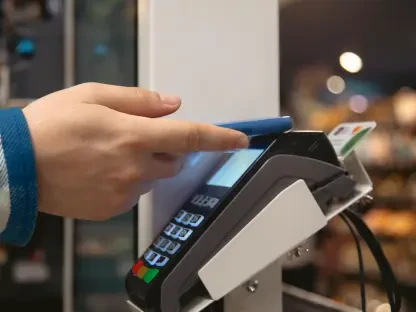In the rapidly evolving retail landscape, UK retailers face a multitude of challenges, primarily revolving around inventory management and accuracy. With current consumer demands and market competition, ensuring accurate inventory availability within stores has become a critical issue. According to a thorough examination of the sector, enhancing inventory availability and accuracy is a top priority for a significant portion of retailers. Out-of-stock items continue to be a major pain point, negatively impacting customer experience and satisfaction. Additionally, economic pressures, including rising operational costs and wages, are compelling retailers to seek innovative solutions to maintain profitability while meeting customer expectations.
The Impact of Inventory Issues on Customer Experience
Stockouts and Customer Dissatisfaction
Inventory issues persist as a major headache for retailers, with a notable percentage expressing a keen interest in improving inventory availability and accuracy. Stockouts present a fundamental challenge, often leading to customer dissatisfaction and loss of sales. A survey has revealed that a substantial fraction of weekly food shopping items still remain unavailable to consumers, which adversely affects the shopping experience. The widespread stockouts not only frustrate consumers but also drive them to seek alternatives elsewhere, posing a considerable risk to the retailer’s brand loyalty.
To combat these issues, many retailers are turning to advanced technologies to optimize inventory management and enhance overall product availability. Digital solutions, such as digital shelf-edge technologies and computer vision, are being leveraged to better monitor and manage stock levels within stores. Collaborative efforts by companies focusing on these technological innovations aim to reduce stockouts, thereby enriching the consumer shopping journey. These digital solutions are poised to revolutionize inventory practices, offering real-time insights and proactive management capabilities that can significantly mitigate stockout occurrences.
Collaborative Technological Approaches
In response to the pressing need for inventory innovation, several retailers are adopting collaborative approaches, partnering with technology-focused enterprises to advance inventory management solutions. Collaborative efforts are essential to bridging the gap in inventory management by introducing cutting-edge digital solutions. Such partnerships foster the integration of digital shelf-edge systems and computer vision technologies into retail operations, enhancing product availability and inventory precision.
By effectively utilizing these technologies, retailers can better predict demand patterns, optimize stocking strategies, and ultimately improve customer experiences. These data-driven insights allow for more informed decision-making, enabling retailers to adapt swiftly to fluctuations in consumer demand and market dynamics. With real-time information at their fingertips, store managers can make prompt adjustments to inventory levels, thereby reducing inefficiencies and enhancing the overall shopping experience. The focus on collaboration and innovation reflects an industry-wide acknowledgment of technology’s pivotal role in addressing inventory challenges that UK retailers face today.
Economic Pressures and the Drive for Efficiency
Rising Operational Costs and Their Implications
The retail sector is currently grappling with escalating operational costs, driven by factors such as increased National Insurance Contributions and higher National Living Wages. These financial pressures are forcing retailers to explore strategies to reduce costs without compromising service quality. A significant proportion of retailers have identified cost reduction in store operations as a primary focus area, with labor efficiency being equally important due to surging wage expenses.
As a strategy to mitigate these cost pressures, retailers are investing in automation and innovative technologies positioned to streamline operations and enhance labor efficiency. By enabling more efficient workflows and reducing manual burdens, automation technologies are helping retailers to operate more cost-effectively amidst financial constraints. Additionally, these technologies enable retailers to redeploy human resources toward customer-facing roles, thereby enriching the customer service experience even as operational budgets tighten.
Automation as a Solution
In navigating the challenging economic landscape, many retailers are turning to automation as a key solution for increasing operational efficiency. Automation technologies can significantly reduce reliance on manual labor, compensate for labor shortages, and enhance the productivity of existing staff. By automating mundane and repetitive tasks, retailers can redirect human capital toward customer engagement and other value-added activities.
Moreover, automation extends beyond labor efficiency, offering potential benefits in inventory management and customer engagement. From self-checkout systems to sophisticated inventory tracking tools, automation allows retailers to optimize their supply chain processes and improve the accuracy of stock levels. This capability not only reduces operating expenses but also aids in fulfilling customer demands more effectively. With the advancement and adoption of automation technologies, retailers are better equipped to balance economic pressures with customer experience enhancements, addressing the critical challenges head-on.
Strategic Adaptations for Retailers
Leveraging Technology for a Competitive Edge
Technology’s role in enhancing retail efficiency and customer satisfaction cannot be overstated. Retailers are increasingly recognizing the need to integrate technological solutions to stay competitive in a challenging economic environment. In particular, utilizing technology for efficient pricing updates, precise inventory management, and dynamic e-commerce solutions is vital to maintaining an edge. By investing in these technological capabilities, retailers can streamline their operations, improve accuracy, and ensure superior customer experiences.
Technology-driven strategies enable retailers to swiftly adapt to changing market demands and consumer expectations. For instance, implementing advanced pricing tools allows for real-time pricing adjustments based on market trends and competition. Simultaneously, efficient inventory management systems ensure optimal stock levels, reducing the likelihood of both overstock and stockouts. By embracing these tech-driven methodologies, retailers can maintain customer satisfaction while operating efficiently.
Future Outlook and Considerations
In the rapidly transforming retail sector, retailers in the UK are grappling with numerous hurdles, primarily centered around inventory management and precision. With ever-changing consumer demands and fierce market competition, ensuring accurate inventory in stores has emerged as a key concern. Analyzing the industry reveals that a large segment of retailers places paramount importance on enhancing inventory availability and precision. Persisting issues with out-of-stock items significantly detract from customer satisfaction and experience. Furthermore, economic challenges, including escalating operational costs and wages, are driving retailers to explore innovative strategies for maintaining profitability while meeting customer expectations. As the retail environment continues to evolve, adopting solutions like advanced technology and data analytics is crucial. This approach allows retailers to refine processes, optimize inventory, and improve customer service, ensuring they remain competitive in a dynamic marketplace.









